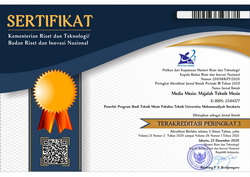COMPUTATIONAL FLUID DYNAMIC (CFD) SIMULATION ON REDESIGN BAFFLES OF YOGYAKARTA INTERNATIONAL AIRPORT TRAIN FUEL TANK
Putri Novia(1*), Bi Asngali(2), Agus Susanto(3), Riant Adzandy(4), Hedi Purnomo(5)(1) Madiun State Polytechnic
(2) Madiun State Polytechnic
(3) Madiun State Polytechnic
(4) PT. Industri Kereta Api (Persero)
(5) PT. Industri Kereta Api (Persero)
(*) Corresponding Author
Abstract
The tank is one of the most important components in the train which serves as a place to store train fuel. However, so far the tank has been a component that has gone unnoticed, even though there is a very important issue to consider, namely how the fluid moves in the tank due to the movement of the train while moving. The free movement of the liquid fluid in a tank is called sloshing. Sloshing in the tank can be reduced by adding anti-sloshing in the tank called component baffles. So it is necessary to simulate the sloshing due to the movement of the train by taking into account the value of the vehicle subsystem of the train and the variation of the baffles design used. There are several models of fuel tank baffles used in this study, namely fuel tanks without baffles; longitudinal baffles (2) lateral baffles (1) - existing baffles; longitudinal baffles (3) lateral baffles (3) with circular perforations; and horizontal (2) lateral (1) baffles with circular perforations. This study aims to provide a baffles design configuration that can optimally reduce the sloshing that occurs. So in this study, a simulation of the fuel tank with variations in the baffles was carried out by applying the Computational Fluid Dynamic (CFD) method. From the simulation results, it is concluded that the configuration of longitudinal baffles (3) lateral baffles (3) has the best performance with an effectiveness of 34.33% in reducing sloshing.
Keywords
Full Text:
PDFReferences
Arsad, A. K. dan Sulisetyono, A. 2013. Studi Gerakan Sloshing terhadap Tangki Kotak (Rectangular Tank) Dengan dan Tanpa Pelat Memanjang (Baffle) Akibat Gerakan Rolling Kapal Dengan Metode Computational Fluid Dynamics (CFD). Jurnal Teknik Pomits. Vol. 2, No. 1, (2013) ISSN: 2337-3539 (2301-9271 Print).
Lee, S. J., & Kim, M. H. 2008. The Effects Of Tank Sloshing On LNG Vessel And Floating Terminal Responses. [Draft] IWWWFB.
Belakroum, R., et. al. 2010. An Efficient Passive Technique for Reducing Sloshing In Rectangular Tanks Partially Filled With Liquid. Mechanics Research Communications.
Jung, J. H., et. al 2012. Effect Of The Vertical Baffle Height On The Liquid Sloshing In A Three-Dimensional Rectangular Tank. Ocean Engineering.
Thabet, S., et. al. 2018. Computational Fluid Dynamics: Science of the Future. International Journal of Research and Engineering.
Fatchurrohman, N., & Chia, S. T. 2017. Performance of hybrid nano-micro reinforced mg metal matrix composites brake calliper: Simulation approach. IOP Conference Series: Materials Science and Engineering.
Subagyo, Rachmat. 2018. Mekanika Fluida I. Banjarbaru: Fakultas Teknik - Universitas Lambung Mangkurat.
Ghurri, Ainul. 2014. Dasar-Dasar Mekanikal Fluida. Bali: Jurusan Teknik Mesin - Universitas Udayana.
Rognebakke, O., et. al. 2009. Sloshing Impact Design Load Assessment. Proceedings of the Nineteenth (2009) International Offshore and Polar Engineering Conference. Osaka, Japan, June 21-26, 2009.
Jin, H., et. al. 2014. Experimental study on sloshing in a tank with an inner horizontal perforated plate. Ocean Engineering.
Article Metrics
Abstract view(s): 1202 time(s)PDF: 929 time(s)
Refbacks
- There are currently no refbacks.








